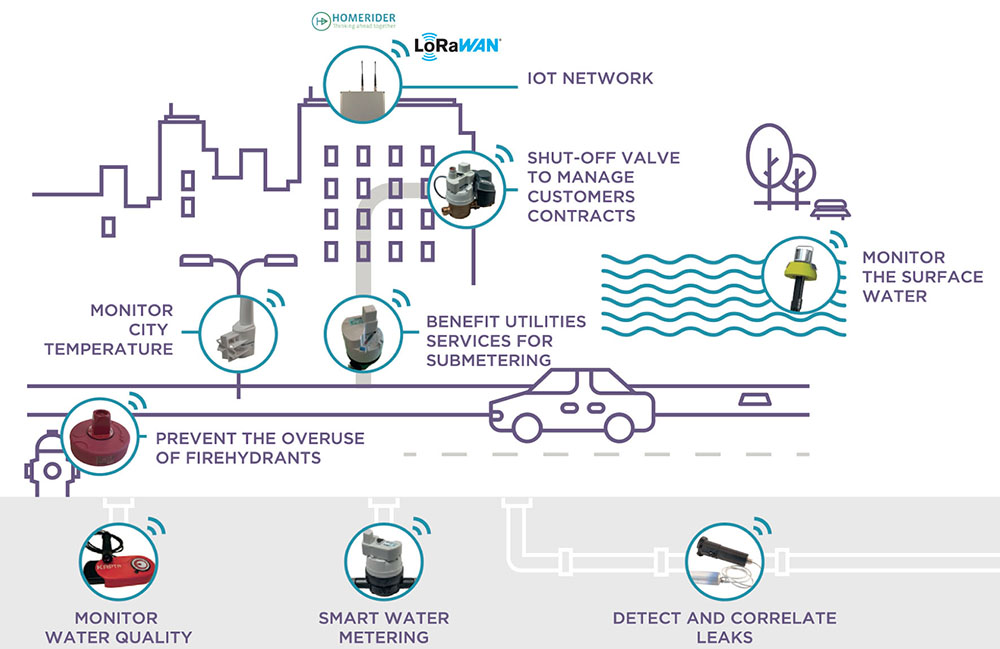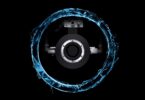
Author: Rémi Demerlé
One of the major challenges facing water utilities is the need to manage water supplies effectively and efficiently.
This requires data, but it’s not always easy or convenient to get measurements or status reports from components such as valves, flow meters or water analysis sensors.
Hardwired connections to meters may be impractical because of the remote areas they are sited in or because they are in hard to access sites such as underground or in places that pose a risk to installers.
In many areas of water treatment and distribution, Semtech’s LoRa® technology is proving an effective way of obtaining data.
A type of low power wide area network (LPWAN), LoRa initially made inroads into electricity metering and the technology is now helping water utilities and their customers monitor the use of this valuable resource.
LoRa connected devices are helping lead the fight against non-revenue water
LoRa is an ideal connectivity technology for water utilities because it works over an extremely long range – measured in kilometres – achieving penetration both indoors, outdoors and deep underground. It also offers very long battery life, making maintenance less of a concern.
In addition to smart metering, LoRa connected devices are helping lead the fight against non-revenue water. It’s estimated that typically over 25% of the clean water produced by utilities is lost, with causes including leaks, inaccurate measurements, misuse and inefficiency.
An increasing number of companies are now adopting LoRa to detect water leaks with acoustic sensors. They are also developing LoRa based sensors to help utilities monitor water quality parameters in reservoirs and other sources, such as conductivity, temperature, turbidity, chlorine content and dissolved oxygen.
For example, French company Birdz, offers its SWARM buoy, which can be deployed on all types of lakes or other water bodies. SWARM monitors parameters including conductivity, dissolved oxygen and temperature, and communicates via an encrypted data stream.
Building a complete Internet of Things (IoT) system is made straightforward by a comprehensive system offered by Subeca. Built on open architecture, the Subeca System can be integrated quickly and easily with any existing IoT infrastructure or expanded into new IoT applications. Once installed, water utilities have an open LoRa IoT network that can be used for a host of other smart city applications.
LoRa-based sensors help utilities tackle challenges from events such as drought and water shortages to storm events and flooding
The Telog 41 series of sensors from Trimble are designed to help utilities achieve better tracking, measurement and reporting of water usage, sanitary and combined-sewer overflows (CSO/SSO) and flooding, leakage and non-revenue water.
The LoRa-based sensors, which include pressure, level, flow and rainfall monitoring devices, help utilities tackle challenges from events such as drought and water shortages, storm events and flooding, as well as conform to environmental regulations.

Keeping water cleaner
The technology is also being used in water treatment plants to capture data on chemical and biological conditions and ensure industries can meet legal discharge standards.
LoRa connected devices can also report on water quality and pollutants to protect water courses and fish farms.
In domestic settings, connected smart shut off valves detect leaks and cut off supply before damage is caused to households or other properties.
Most householders dread a major water leak, with the cost running into many thousands of euros, not to mention weeks of inconvenience.
The situation could be even worse if a leak goes undetected for some time – if it occurs in an area of the house that is not often occupied, or if the householder is away, the leak could cause significant damage before it is detected.
As well as the costly structural damage, leaks can encourage the rapid growth of harmful moulds that affect people’s health.
IoT technology combined with LoRa connectivity can be used to predict and prevent water leaks in the home.
If a leak occurs, real-time alerts notify the residents, allowing swift action to prevent serious damage to the property
For example, for areas that pose a significant risk of water leakage, such as kitchens, utility and laundry rooms, bathrooms and areas housing boilers and water tanks, LoRa enabled humidity and temperature sensors can be installed.
If a leak occurs, real-time alerts notify the residents, allowing swift action to prevent serious damage to the property.
Similarly, connected smart shut off valves can detect leaks and cut off supply before damage can occur.
Examples here include Strega’s wireless Smart Valve, which detects a leak then immediately closes the valve and reports the issue to the householder’s mobile device. It can also shut off the valve once a permitted monthly number of litres has been reached.
A similar product is the Switch-Flow from Hydrelis, designed to automatically cut the inflow of water in the event of leakage or pipe bursts. It can also limit the daily volume of water through the valve and can be programmed to open and close the valve at set times.
Keeping consumption in check
Sainte-Lisaigne offers its Wayve smart boxes to help water utilities control and manage water supply to households and other users. IoT enabled, they can detect water leaks and shut off valves, be programmed to conduct automated flushing of pipes, turn on valves to prevent water pipes freezing and control water supply remotely to optimize consumption. Municipalities can also use them to control facilities such as water fountains.
Although LoRa is well known for smart water metering, it can also support many additional IoT use cases on the network – in fact, new IoT sensors for utilities are growing faster than metering and far from being restricted to water applications, LoRa has the flexibility to work across all utilities.
There are currently over 150 LoRaWAN networks in over 170 countries, according to the LoRa Alliance®. With a large ecosystem of developers, suppliers and providers, water utilities and their customers have a greater choice of applications and a greater number of device makers that can incorporate more widely deployed technologies into their device. This large ecosystem produces a great availability of smart meters and IoT sensors with LoRaWAN certification.
With LoRa-integrated smart metering, water utilities are ensuring they maintain public trust, grow their businesses effectively at optimized costs and continue to meet the legal obligations imposed by environmental legislators around the world.
About the Author
Rémi Demerlé is the Director, Developer Ecosystem, WSP LoRa Alliance and Community at Semtech, and a Board Member of DLMS User Association.
About the Company
Semtech is a leading global supplier of high-performance analogue and mixed-signal semiconductors and advanced algorithms for infrastructure, high-end consumer and industrial equipment. Semtech’s LoRa device-to-Cloud platform is a globally adopted long range, low power solution for IoT applications, enabling the rapid development and deployment of ultra-low power, cost efficient and long range IoT networks, gateways, sensors, module products, and IoT services worldwide.
Semtech, the Semtech logo and LoRa are registered trademarks or service marks of Semtech Corporation or its affiliates.
Do you have an article or video that you would like to share? Submit your article here or keep up with the latest news from the water industry and wastewater industry by subscribing to our weekly newsletter.







